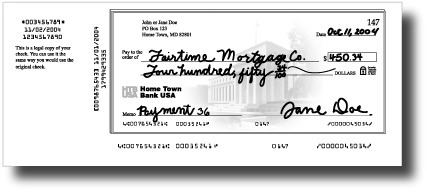 | ||
Cheque truncation (check truncation in American English) is the conversion of a physical cheque into a substitute electronic form for transmission to the paying bank. Cheque truncation reduces or eliminates the physical movement of cheques and reduces the time and cost of processing the cheque clearance system. Cheque truncation also offers the potential reduction in settlement periods with the electronic processing of the cheque payment system.
Contents
History
To settle a cheque, it has to be presented to the drawee bank for payment. Originally this was done by taking the cheque to the drawee bank, but as cheque usage increased this became cumbersome and banks arranged to meet each day at a central location to exchange cheques and settle the money. This became known as central clearing. Bank customers who received cheques could deposit them at their own bank, who would arrange for the cheque to be returned to the drawee bank and the money credited to and debited from the appropriate accounts. If a cheque was dishonoured or bounced it would be physically returned to the original bank marked as such.
This process would take several days, as the cheques had to be transported to the central clearing location, from where they were taken to the payee bank. If the cheque bounced, it would be sent back to the bank where the cheque was deposited. This is known as the clearing cycle.
Cheques had to be examined by hand at each stage, which required a large amount of manpower.
In the 1960s, machine readable codes were added to the bottom of cheques in MICR format, which allowed the clearing and sorting process to be automated. This helped to speed up the clearing process; however the law in most countries still required the cheques to be delivered to the payee bank, and so physical movement of the paper continued.
Starting in the mid-1990s, some countries started to change their laws to allow "truncation": cheques would be imaged and a digital representation of the cheque would be transmitted to the drawee bank, and the original cheques were destroyed. The MICR codes and cheque details are normally encoded as text in addition to the image. The bank where the cheque was deposited would typically do the truncation and this dramatically decreased the time it took to clear a cheque. In some cases, large retailers that received large volumes of cheques could also do the truncation.
Once the cheque has been turned into a digital document, it can be processed through the banking system just like any other electronic payment.
Laws
Although technology needed to exist to be able to truncate a cheque, it was the laws related to cheques that were the main impediment to their introduction. New Zealand was one of the first countries to introduce truncation and imaging of cheques, when in 1995 the Cheques Act 1960 was amended to provide for the electronic presentation of cheques. A number of other countries followed over the next few years, but progress was mixed due to the decline in the use of cheques generally in favour of electronic payment systems. Some countries decided that the effort to implement truncation could not be justified for a declining payment method, and instead phased out the use of cheques altogether.
In 2004, the Check 21 Act was implemented in the United States to authorize conversion of the original paper check into an electronic image for presentation through the clearing process. The law also enacted the recognition and acceptance of a "substitute check" created by a financial institution in lieu of the original paper check. Any bank that receives the original paper check can remove or "truncate" the paper check from the clearing process.
New laws needed to address ways to make sure that the digital image was a true and accurate copy of the original cheque, as well as a mechanism to enable the process to be audited to protect consumers.
It also needed to address the process for dishonoured cheques, as cheques could no longer be returned. A typical solution, as defined by the Monetary Authority of Singapore for the Singapore cheque truncation system, was that a special 'Image Return Document' was created and sent back to the bank that had truncated the cheque.
Operations and clearing
The security related to imaging and creating the electronic cheque needed to be defined and the cheque clearing process adjusted to accommodate electronic cheques.
Banks and financial institutions use cheque truncation systems (CTS) to manage this process. These systems have to deal with two main processes, outward clearing and inward clearing.
In outward clearing, the deposited items are scanned and the operator performs amount entry, account entry, item verification, balancing and bundling of the items at the branch level. The items are then sent to a service branch.
In inward clearing, the items received from branches are processed in the service branch where the operator performs amount entry, account entry, item verification, balancing and bundling of the items. Once verification is complete, the items are sent to the clearing house. Those items that failed validation due to discrepancies are sent back to the originating branch to be corrected.
Some banks have modified their own bank systems or built proprietary system to handle truncation, there are also a number of software companies that provide commercial solutions and services. These include:
